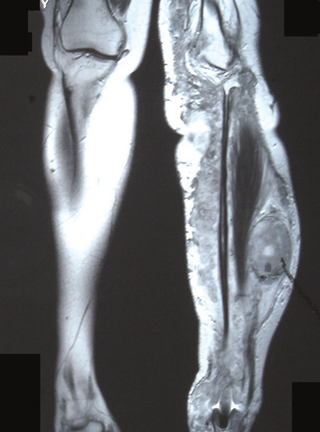Top Qs
Timeline
Chat
Perspective
Peripheral nerve tumor
Medical condition From Wikipedia, the free encyclopedia
Remove ads
Peripheral nerve tumors, also called tumors of peripheral nerves or tumors of the peripheral nervous system, are a diverse category with a range of morphological characteristics and biological potential.[1] They are categorized as either benign or malignant peripheral nerve sheath tumors.[2][3]
Remove ads
Description
Summarize
Perspective
They vary from benign (soft tissue perineurioma and schwannoma) that can be completely removed to benign (plexiform neurofibroma) that may be locally aggressive to extremely malignant (malignant peripheral nerve sheath tumors [MPNST]).[1] New and more precisely defined entities include malignant melanotic nerve sheath tumor (formerly known as melanotic schwannoma) and hybrid nerve sheath tumors.[4][5] The majority of peripheral nerve tumors are benign tumors of the nerve sheath (usually schwannomas); on rare occasions, they are metastatic tumors or originate from the nerve cells.[6][7]
Most peripheral nerve tumors occur for unknown reasons. Some, including schwannomatosis and neurofibromatosis (types 1 and 2), are associated with recognized hereditary disorders. Others may be caused by gene mutations. In the case of schwannomatosis and neurofibromatosis, tumors can grow on or close to nerves anywhere in the body. Frequently, there are several tumors.[8]
The typical symptoms involve a combination of pain, loss of nerve function, and/or a palpable (or radiographically apparent) mass affecting a peripheral nerve. The etiology and importance of the last two symptoms should be apparent. For example, the presence of a severe nerve palsy is highly suggestive of malignancy as it is most likely the result of the tumor invading and destroying nerves.[7]
Methods used to identify tumors of the peripheral nervous system include a family history of any predisposition syndrome, including neurofibromatosis types 1 and 2, a targeted and comprehensive physical examination, and radiological investigations, the primary one being magnetic resonance imaging.[9][10] Other radiological investigations may include plain radiographs, ultrasound examination, computed tomography, and positron emission tomography.[11] Definitive diagnosis is made by tumor biopsy.[12] Surgery is the most common method of treating peripheral nerve sheath tumors.[11] In malignant tumors, complete resection is the only known curative treatment (with a sufficiently wide margin or even amputation to improve prognosis).[12] For larger lesions or those with a more aggressive histology, adjuvant radiation is recommended. Novel or combination therapies that are the focus of ongoing clinical trials are highly desirable.[13][14]
Remove ads
Epidemiological and clinical features
Summarize
Perspective
Formally, the majority of these tumors lack a CNS WHO grade; instead, neoplasms should be graded within each category of tumor.[5]
Remove ads
References
Wikiwand - on
Seamless Wikipedia browsing. On steroids.
Remove ads

